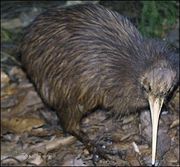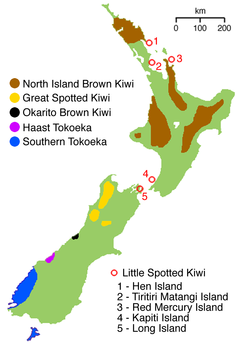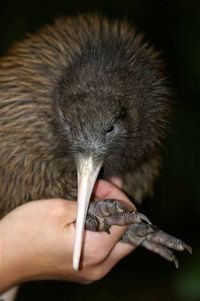Kiwi
Conservation status: Vulnerable |

|
|
Scientific classification |
| Kingdom: |
Animalia
|
| Phylum: |
Chordata
|
| Class: |
Aves
|
| Order: |
Struthioniformes
|
| Family: |
Apterygidae
G.R. Gray, 1840 |
| Genus: |
Apteryx
Shaw, 1813 |
|
| Species |
|
See text. |
A kiwi is any of the species of small
flightless birds endemic to
New Zealand of the genus Apteryx (the only
genus in family Apterygidae). At around the size of a
domestic
chicken, kiwi are by far the smallest living
ratites. Several kiwi species are
endangered. The kiwi is also a national symbol for New
Zealand.
Habitat
Prior to the arrival of humans in the
13th century or earlier, New Zealand's only endemic mammals
were three species of bat, and the ecological niches that in other parts of the world were
filled by creatures as diverse as horses, wolves and mice
were taken up by birds (and, to a lesser extent, reptiles).
Kiwi are shy and usually
nocturnal. Their mostly nocturnal habits may be a result of
habitat intrusion by predators including man, resulting in
kiwis that prefer day-time activities loosing out . This
seems evident in areas of New Zealand where introduced
predators have been removed like sanctuaries where kiwis are
often seen in day light. Kiwis are creatures with a highly
developed sense of smell and, most unusual in a bird,
nostrils at the end of their long bill. They feed by
thrusting the bill into the ground in search of worms,
insects, and other invertebrates; they also take fruit and,
if the opportunity arises, small crayfish, amphibians and
eels.
After an initial meeting during mating season (March to
June), kiwi usually live as monogamous couples, unless a
more suitable mate arises. The pair will meet in the nesting
burrow every few days and call to each other at night. These
relationships have been known to last for up to 20 years.
(Source:
KiwiRecovery.org) Kiwi eggs can weigh up to one quarter
the size of the female. Usually only one egg is laid.
Although the kiwi is about the size of a domestic chicken,
it is able to lay eggs that are up to ten times larger than
a chicken's egg. (Source: Grzimek's Animal Life
Encyclopedia)
Their adaptation to a terrestrial life is extensive: like
all ratites they have no keel on the breastbone to anchor
wing muscles, and barely any wings either: the vestiges are
so small that they are invisible under the kiwi's bristly,
hair-like, two-branched feathers. While birds generally have
hollow bones to save weight and make flight practicable,
kiwi have marrow, in the style of mammals. With no
constraints on weight from flight requirements, some Brown
Kiwi females carry and lay a single 450 g
egg.
It was long presumed that the kiwi's closest relatives
were the other New Zealand ratites, the
moa.
However recent
DNA
studies indicate that the
Ostrich is more closely related to the
moa
and the kiwi's closest relatives are the
Emu
and the
cassowaries. This theory suggests that the kiwi's
ancestors arrived in New Zealand from elsewhere in
Australasia well after the
moa.
According to British scientists, the kiwi may be an
ancient import from Australia. Researchers of Oxford
University have found DNA
evidence connected to Australia's
Emu
and the
Ostrich of Africa. Upon examining
DNA
from New Zealand's native
moa,
they believe that the kiwi is more closely related to its
Australian cousins. (Source:
News In Science)
Species
Currently there are five accepted species (one of which
has four sub-species), plus one to be formally described:

The distribution of each species of kiwi
- The largest species is the Great Spotted Kiwi,
Apteryx haastii, which stands about 450 mm high
and weighs about 3.3 kg. (Males about 2.4 kg) It has
grey-brown
plumage with lighter bands. The female lays just one
egg, with both sexes incubating. Population is estimated
to be over 20,000, distributed through the more
mountainous parts of northwest Nelson, the northern West
Coast, and the Southern Alps.
- The very small Little Spotted Kiwi,
Apteryx owenii is unable to survive predation by
imported pigs, stoats and cats and is extinct on the
mainland and the most threatened of all kiwi. About 1350
remain on Kapiti Island and it has been introduced to
other predator-free islands and appears to be becoming
established with about 50 'Little Spots' on each island.
A docile bird the size of a bantam, it stands 250 mm high and the female weighs
1.3 kg. She lays one egg which is incubated by the male.
- The North Island Brown Kiwi, Apteryx
mantelli is widespread in the northern two-thirds of
the North Island and with about 35,000 remaining is the
most common kiwi. Females stand about 400 mm high and
weigh about 2.8 kg, the males about 2.2 kg. The North
Island Brown has demonstrated a remarkable resilience:
it adapts to a wide range of habitats, even non-native
forests and some farmland. The plumage is streaky
red-brown and spiky. The female usually lays two eggs,
which are incubated by the male.
- The
Rowi, also known as the Okarito Brown Kiwi
or Apteryx rowi, is a recently identified
species, slightly smaller, with a greyish tinge to the
plumage and sometimes white facial feathers. Females lay
as many as three eggs in a season, each one in a
different nest. Male and female both incubate.
Distribution of these kiwi are limited to a small area
on the west coast of the South Island of New Zealand.
- The Southern Tokoeka, Apteryx australis
australis, relatively common species of kiwi known
from southwest South Island (Fiordland) that occurs at
most elevations. It is approximately the size of the
Great Spotted Kiwi and is similar in appearance to
the Brown Kiwi but its plumage is lighter in
colour.
- The Stewart Island Tokoeka, Apteryx
australis lawryi, is a subspecies of Southern
Tokoeka known from Stewart Island.
- The Haast Tokoeka, Apteryx n. sp. (?fusca),
is the rarest species of kiwi with only about 300
individuals. It was identified as a distinct form in
1993. It only occurs in a restricted area in South
Island's Haast Range at an altitude of 1,500 m. This
form is distinguished by a more strongly downcurved bill
and more rufous plumage.

North Island Brown Kiwi
Analysis of mitochondrial DNA, ecology, behaviour,
morphology, geographic distribution and parasites of the
North Island Brown Kiwi has led scientists to propose that
the Brown Kiwi is three distinct species. The North Island
Brown Kiwi; the Okarito Brown Kiwi (Rowi), whose
distribution is restricted to a single site on the West
Coast of the South Island of New Zealand; and a third
distinct population of the North Island Brown Kiwi, the
Southern Tokoeka, distributed in the in lowland forest to
the north of Franz Josef glacier in the South Island and on
Stewart Island, with a small population near Haast being another possibly distinct species, the Haast
Tokoeka.
Discovery and documentation
The first kiwi specimen to be studied by Europeans was a
kiwi skin brought to
George Shaw by Captain Andrew Barclay aboard the ship
Providence, who was reported to have been given it by a
sealer in Sydney Harbour around 1811. George Shaw gave the kiwi
its scientific name and drew sketches of the way he imagined
a live bird to look which appeared as plates 1057 and 1058
in volume 24 of The Naturalist's Miscellany in 1813.
Food
The kiwi birds eat spiders, beetles, catepillars, seeds,
grubs, and many varities of worms. Of course, their long
beaks make it easy to catch prey.
References
- Burbidge M.L., Colbourne R.M., Robertson H.A., and
Baker A.J. (2003). Molecular and other biological
evidence supports the recognition of at least three
species of brown kiwi.
Conservation Genetics 4(2):167-177
- Cooper, Alan et al (2001). Complete mitochondrial
genome sequences of two extinct moas clarify ratite
evolution in Nature 409: 704-707.
-
News In Science
External links




